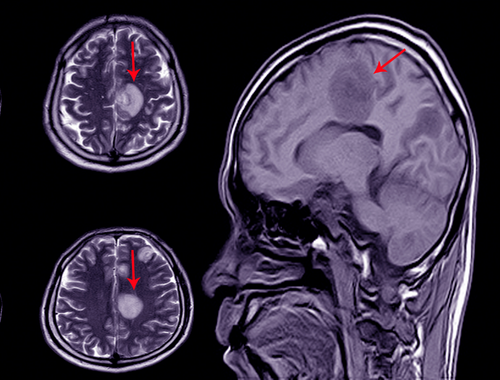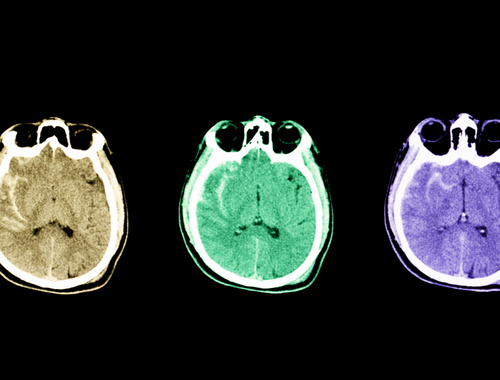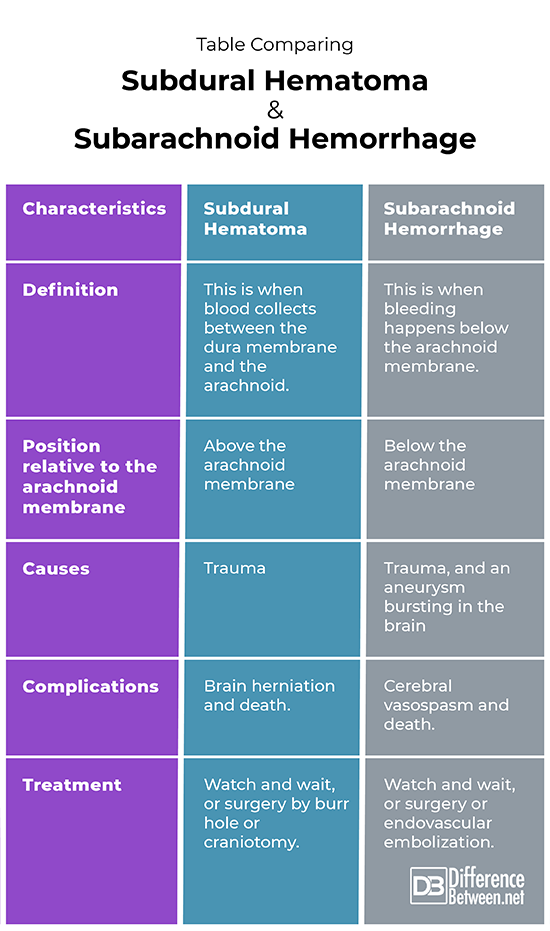Difference Between Subdural Hematoma and Subarachnoid Hemorrhage
• Categorized under Science | Difference Between Subdural Hematoma and Subarachnoid Hemorrhage
A subdural hematoma is a collection of blood that happens between the arachnoid and dura membrane of the brain. A subarachnoid hemorrhage is a bleed that occurs below the arachnoid membrane of the brain.

What is Subdural hematoma?
Definition:
A subdural hematoma is a condition where there is a bleed between the dura membrane and the arachnoid membrane of the brain.
Causes and prevalence:
A subdural hematoma is usually due to trauma. A fall or some other blow to the head can cause blood vessels to tear and cause bleeding between these two brain meninges.
Symptoms and complications:
Symptoms of a subdural hematoma include mental confusion, headache, nausea, vomiting, and passing out. Other signs include feeling dizzy and weak, a change in mood, and having seizures. Brain herniation is a potential complication of a subdural hematoma. This is when the extra pressure caused by the blood pushes the brain tissue down into the spinal cord. This can quickly result in death.
Diagnosis:
Diagnosis is made by doing imaging tests. Imaging such as a CT scan or MRI can show the presence of blood in the skull.
Treatment:
The course of treatment depends on the extent of the bleeding. In the case of a very small hematoma, doctors may opt to wait and see how the patient progresses. In a larger bleed surgery is needed to remove the blood and decrease the pressure on the brain. Surgery is sometimes done by burr hole trephination where a small hole is drilled into the skull, but sometimes surgery is done by craniotomy where part of the skull needs to be removed.

What is Subarachnoid hemorrhage?
Definition:
A subarachnoid hemorrhage is when there is a bleed that happens below the arachnoid membrane of the brain.
Causes and prevalence:
The causes of a subarachnoid bleed include an aneurysm that bursts or a traumatic injury to the brain such as may happen in an accident of some sort where the head receives a hard blow.
Symptoms and complications:
The most common symptom of a subarachnoid hemorrhage is a very sudden and very severe headache. The person may also feel nauseated, have vomiting, and have a stiff neck. They may pass out and have difficulty with their eyesight. Cerebral vasospasm in which the blood vessels in the brain go into a spasm is a complication of subarachnoid hemorrhage. If the blood vessels spasm enough the blood flow to the brain can be cut off resulting in death.
Diagnosis:
The diagnosis of a subarachnoid hemorrhage is based on images from a CT scan or MRI test showing fluid collecting in the brain.
Treatment:
A subarachnoid hemorrhage may require surgery depending on how severe the bleed is. A patient needs to be in the hospital where they can be monitored and surgery is done if needed. In some cases where bleeding is from an aneurysm, a doctor can perform an endovascular embolization. In this method, the doctor inserts a catheter and passes this into the brain. The catheter contains coils that can be used to repair the aneurysm.
Difference between Subdural hematoma and Subarachnoid hemorrhage?
Definition
A subdural hematoma is when blood collects between the dura membrane and the arachnoid. A subarachnoid hemorrhage is when bleeding happens below the arachnoid membrane.
Position relative to the arachnoid membrane
A subdural hematoma is when there is a bleed that happens above the arachnoid membrane. A subarachnoid hemorrhage is when a bleed occurs that is below the arachnoid membrane.
Causes
The cause of a subdural hematoma is a type of trauma where the head is hit. The cause of a subarachnoid hemorrhage is a traumatic blow to the head or a burst aneurysm.
Complications
Common complications of a subdural hematoma are brain herniation and death. Common complications of a subarachnoid hemorrhage are cerebral vasospasm and death.
Treatment
Watch and wait or surgery by burr hole or craniotomy is the course of treatment for a subdural hematoma. With a subarachnoid hemorrhage the treatment is either watch and wait or surgery, or endovascular embolization (where an aneurysm is involved).
Table comparing Subdural hematoma and Subarachnoid hemorrhage

Summary of Subdural hematoma Vs. Subarachnoid hemorrhage
- A subdural hematoma and subarachnoid hemorrhage can both occur because of head trauma.
- A subdural hematoma is a result of a bleed below the dura membrane.
- A subarachnoid hemorrhage is a bleed below the arachnoid membrane.
FAQ
Is intracranial hemorrhage the same as subdural hematoma?
The term intracranial hemorrhage is used interchangeably with subdural hematoma.
What is the difference between subarachnoid and intracranial hemorrhages?
An intracranial hemorrhage can be used to describe any number of bleeds in the brain while a subarachnoid hemorrhage is specific to a bleed that occurs beneath the arachnoid membrane.
What is another name for subarachnoid hemorrhage?
The general term would be a bleed on the brain but usually, doctors use the term subarachnoid hemorrhage to indicate where the bleed is occurring.
What is the difference between hemorrhage and hematoma?
A hemorrhage refers to the state when there is actual active bleeding happening while a hematoma is often used to refer to a clot of blood after bleeding, which has pooled in a specific area.
What are the 4 types of brain bleed?
The four types of brain bleed are as follows: intraparenchymal hemorrhage, epidural and subdural hemorrhage, and finally, subarachnoid hemorrhage.
- Difference Between Rumination and Regurgitation - June 13, 2024
- Difference Between Pyelectasis and Hydronephrosis - June 4, 2024
- Difference Between Cellulitis and Erysipelas - June 1, 2024
Sharing is caring!
Search DifferenceBetween.net :
Cite
APA 7
Osborn, D. (2022, November 25). Difference Between Subdural Hematoma and Subarachnoid Hemorrhage. Difference Between Similar Terms and Objects. http://www.differencebetween.net/science/difference-between-subdural-hematoma-and-subarachnoid-hemorrhage/.
MLA 8
Osborn, Dr. Rae. "Difference Between Subdural Hematoma and Subarachnoid Hemorrhage." Difference Between Similar Terms and Objects, 25 November, 2022, http://www.differencebetween.net/science/difference-between-subdural-hematoma-and-subarachnoid-hemorrhage/.
Leave a Response
Written by : Dr. Rae Osborn. and updated on 2022, November 25
References :
[0]Cleveland Clinic. “Subdural hematoma”. Cleveland Clinic, 2022, https://my.clevelandclinic.org/health/diseases/21183-subdural-hematoma
[1]Mayo Clinic. “Subarachnoid hemorrhage”. Mayo Clinic, 2022, https://www.mayoclinic.org/diseases-conditions/subarachnoid-hemorrhage/symptoms-causes/syc-20361009
[2]Petridis, Athanasios K., et al. "Aneurysmal subarachnoid hemorrhage: diagnosis and treatment." Deutsches Ärzteblatt International 114.13 (2017): 226.
See more about : Subarachnoid Hemorrhage, Subdural Hematoma
